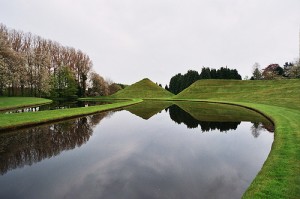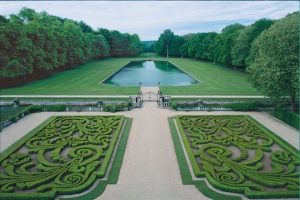The Garden History Museum and the Landscape Institute are holding a seminar (Monday 1st December 10.30am to 4.30pm) on sustainable garden and landscape design. It will be ‘chaired by television presenter and garden designer, Joe Swift’. What a strange event to have planned. Is it an opportunity for Joe The Gardener, or for the Landscape Institute, to learn about the social benefits of sustainable garden and landscape design? For more details see the Press Release.
Monthly Archives: October 2008
Seeking sanctuary: the enclosed garden
The gardens of Chateau de Courances are acknowledged as one of the most integrated examples of an essential relationship between architecture and garden. I would have to agree.
The intricate formal design of the moated parterre garden close to the chateau leading onto the serenity of the pool of water in the garden enclosed by an avenue of trees beyond, gives a gradual sense of dematerialisation from the formal to the natural. This movement from the high artifice of the Chateau with its formal garden to the distant glimpse of what might be the wilderness beyond creates a wistful sense of connection between two differing but equally lovely outdoor environments.
This is a garden for contemplating from windows and for promenading within…but it is best enjoyed in solitude or populated with a profusion of people in a celebratory mood.
The gardens at Courances are considered one of the top fifty gardens by Tim Richardson. Tom’s description is at Gardenvisit.
Image: Parterre, Chateau de Courances, France malcolmkirk.com/galleries
Sacred Gardens and Landscapes
Avebury, Delphi, Ryoanji and Salisbury Cathedral Cloister are sacred places. But are they also gardens? Yes: they are enclosed outdoor spaces; they were designed to be beautiful; they were not made for functional horticulture.
Sun, shadows, water, plants and structures are intrinsic to their design. Ryoanji, you might say, is a dry garden. Yes it is, but moss grows around the famous stones and the play of tree shadows on the gravel is part of the fascination.
According to Wikipedia “Holiness, or sanctity, is the state of being holy or sacred, that is, set apart for the worship or service of gods. It could also mean being set apart to pursue (or to already have achieved) a sacred state or goal, such as Nirvana. It is often ascribed to people, objects, times, or places.” I have one quibble with this definition: the Buddha did not recognize a god and Buddhism is the world religion which has had the most influence on garden design.
In a demythologised sense, if you wish, I believe that sacredness remains a vital concern in garden design. We want to have places which are ‘set apart’ from the everyday world of bustling stress, which fill the soul and solace the flesh. I wish those who plan suburban subdivisions and housing estates had an appreciation of how space can be ‘set apart’ and yet connected.
Lumbini Garden – Buddha's birthplace
 I came across this drawing of the Buddha’s birthplace recently and it reminded me what a cruel thing Kenzo Tange did at Lumbini. Like Corbusier, Tange was a gifted designer and a terrible planner.
I came across this drawing of the Buddha’s birthplace recently and it reminded me what a cruel thing Kenzo Tange did at Lumbini. Like Corbusier, Tange was a gifted designer and a terrible planner.
An ability to design objects (eg buildings) sometimes goes with an understanding of outdoor space, and gardens, but in the case of these two leading architects from West and East it did not. ‘Baroque Buddhism’ is as unwelcome as ‘Baroque Communism’, in politics and in design.
The illustration shows the scene which Fa-hsien described in c400 CE:
“Fifty li east from the city (ie from Kapilavastu) was a garden, named Lumbini, where the queen entered the pond and bathed. Having come forth from the pond on the northern bank, after walking twenty paces, she lifted up her hand, laid hold of a branch of a tree, and, with her face to the east, gave birth to the heir-apparent. When he fell to the ground, he immediately walked seven paces. Two dragon-kings appeared and washed his body. At the place where they did so, there was immediately formed a well, and from it, as well as from the above pond, where the queen bathed, the monks even now constantly take the water, and drink it.”
Laurence Llewelyn-Bowen and 'Britain's Best Garden'
Britain’s TV Channel 5 is running a series (8pm on Thursdays) hosted by Laurence Llewelyn-Bowen and called ‘I own Britain’s Best Garden’. It is a welcome contribution to debate about garden design but the point it dramatizes is the pathetic standard of TV discussion of the subject. Alan Titchmarch blazes the trail each year at Chelsea with remarks like ‘Wow – not bad is it’ and ‘This’ll set your knees wobbling – it certainly does mine’.
Laurence Llewelyn-Bowen is more sophisticated but the impression, perhaps correctly for its audience, is that the presenter, the critics and the designers lack substance in their chosen field. I know that many of the participants earn their living from garden design but this does not make them expert designers or expert design critics.
C’mon producers: you can do better – much, much better. Garden TV has been a massive growth area over the past 20 years. The time is right for a push into quality. Kevin McLeod conducts a more sophisticated discussion about architecture, as does Jeremy Clarkson about cars and Jamie Oliver about food.
Useful note to TV executives: Jeremy Clarkson’s Top Gear sells round and round the world.
Charles Jencks Garden of Cosmic Speculation
 “Gardens like cities are whispering games in which the key is to pass on meaning even as it changes.” And “Design is like a conversation, if you knew the outcome it wouldn’t be worth having…” Charles Jencks in ‘The Garden of Cosmic Speculation’ (2003).
“Gardens like cities are whispering games in which the key is to pass on meaning even as it changes.” And “Design is like a conversation, if you knew the outcome it wouldn’t be worth having…” Charles Jencks in ‘The Garden of Cosmic Speculation’ (2003).
[Image & text source : www.thegrowspot.com/index.php?pageid=amazing-…]


